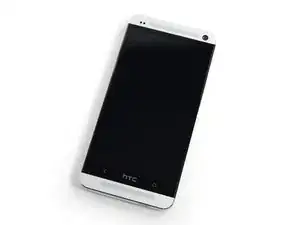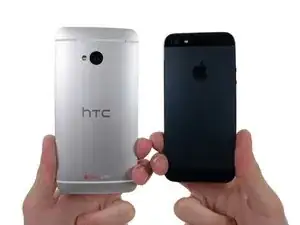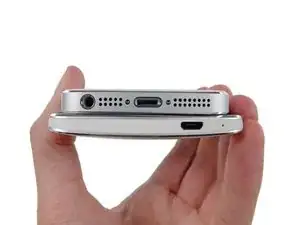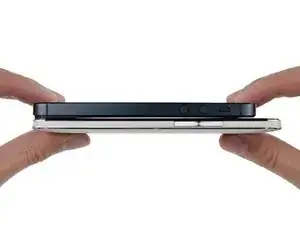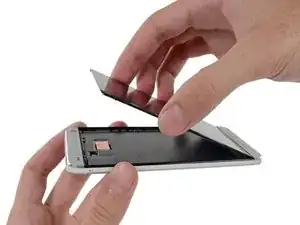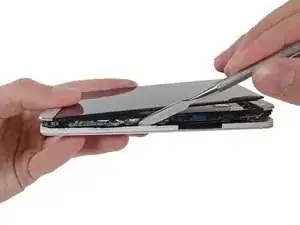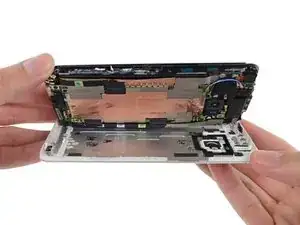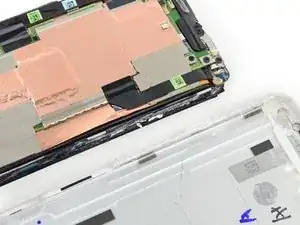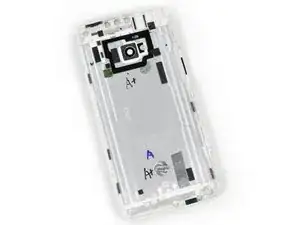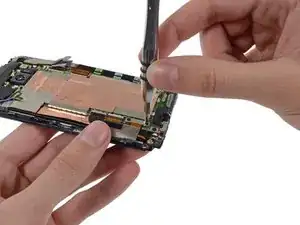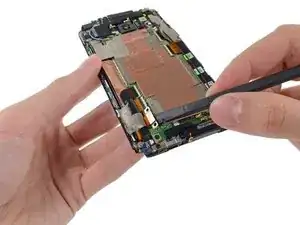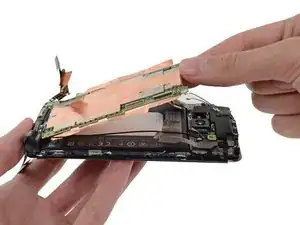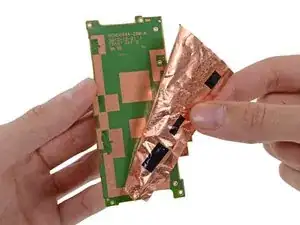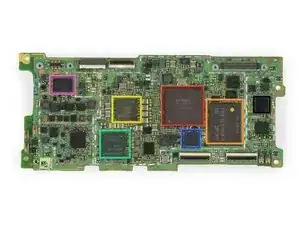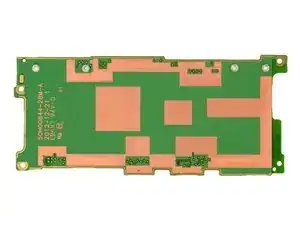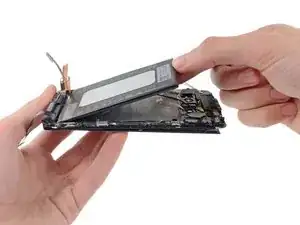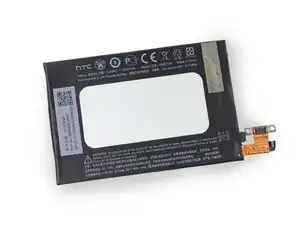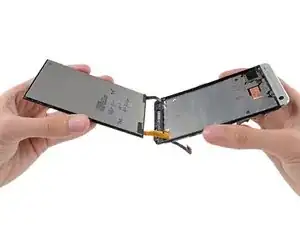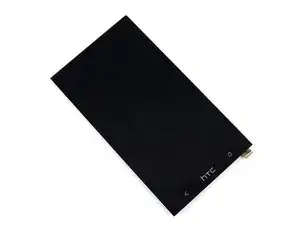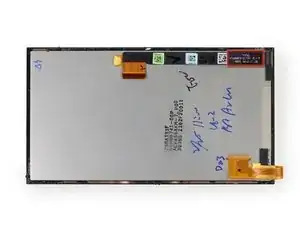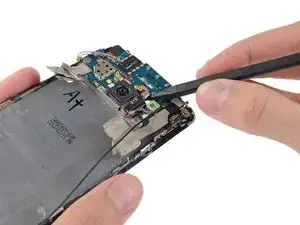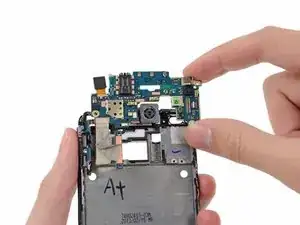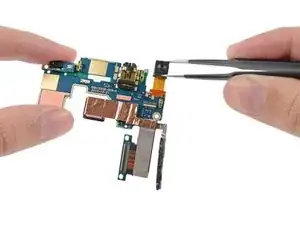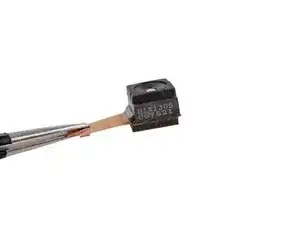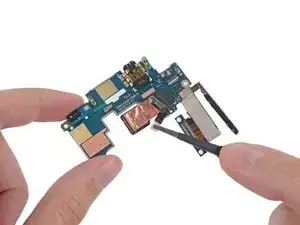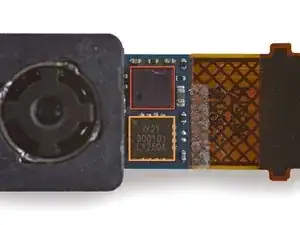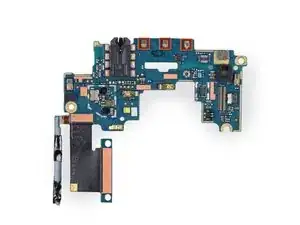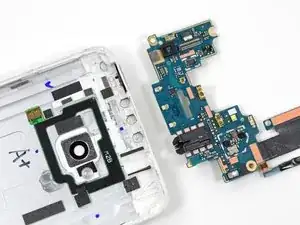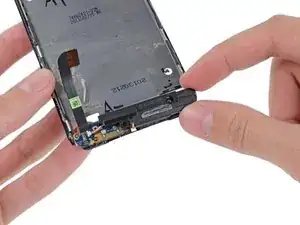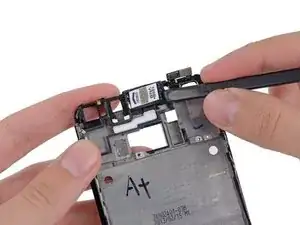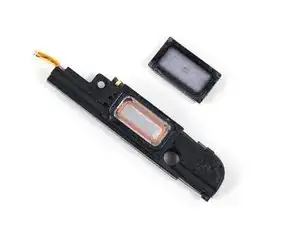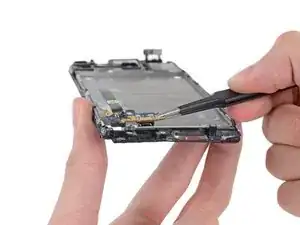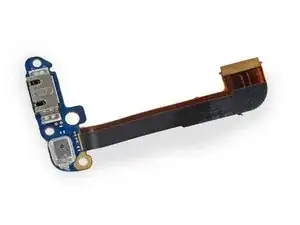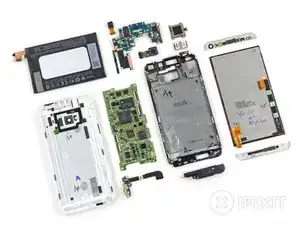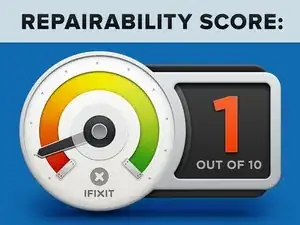Einleitung
Who's gonna save the world tonight? Who's gonna bring you back to life? That's right ladies and gentlemen, the HTC One is here to save the world tonight. Machined from one solid block of aluminum, the HTC One is the One smartphone capable of almost anything. Join us as we disassemble the One phone to rule them all.
Tired of being the last one to know? Planned obsolescence got you down, and you need a quick pick-me-up? Follow iFixit on Twitter or friend us on Facebook for the latest updates on teardowns!
Werkzeuge
-
-
Some people spend their whole lives looking for "the one." We found a suitable candidate and decided to court it the only way we know how: piece by piece.
-
Tech Specs:
-
All-aluminum unibody construction
-
4.7" display with a resolution of 1920x1080 (468 ppi)
-
Qualcomm Snapdragon 600 Quad-Core 1.7 GHz CPU
-
2 GB DDR2 RAM
-
4-megapixel UltraPixel Camera
-
HTC BoomSound
-
-
-
It's no surprise that HTC appears to be taking a cue from the iPhone 5's design pattern in creating a sleek aluminum-bodied phone.
-
Whereas Apple went with a flat backside to keep the iPhone's overall thickness down, HTC wanted a more ergonomic curved back.
-
HTC has said over and over that they wanted to create a seamless product, and the absence of any exterior screws is a testament to that.
-
Unlike the iPhone's volume buttons, which protrude from the case, the One's buttons lie flush with the sides so as not to interrupt the body lines.
-
-
-
To get things started, we dive into the one part of the HTC One that isn't aluminum: the 4.7" 1080p HD display.
-
A small amount of heat and a suction cup were all that was required to create a gap in the One's zero gap construction.
-
-
-
While the display can be lifted, it can't be removed as it is still connected via the display ribbon cables, which are routed underneath the case assembly.
-
In hopes of discovering any hidden screws, we remove the large foam padding adhered to the top of the case assembly.
-
No dice.
-
-
-
With no clear path to entry, we decide to get a little more creative with our approach…for a good half hour.
-
Utilizing the steady hands of a seasoned device surgeon, we free the One's innards from the dungeon-esque aluminum case with a metal spudger.
-
-
-
We won't lie, getting to this point was an arduous and daunting task. The amount of work required to separate the rear aluminum case and the front case was immense.
-
Nevertheless, we present to you the contents of the One.
-
Our diligent spudgering appears to have permanently mangled the plastic bezel surrounding the aluminum case. It's possible that prying at a snail's pace while applying heat could minimize this damage, but we're not too hopeful. This phone was not made with open-ability in mind.
-
-
-
The number one standout feature of the One is certainly the aluminum unibody, which required much custom tooling on HTC's part to achieve the perfect fit and finish.
-
Around the camera bezel we find the near-field communications (NFC) antenna and its pressure contacts. NFC has recently become pretty standard in the smartphone industry, something that might have helped the Nexus Q gain more traction last year.
-
-
-
The back of the One is covered in a sea of copper tape and ribbon cables, and only after a diligent search are we able to locate the battery connector—although no clear path to the battery itself.
-
-
-
The motherboard of the HTC One is pretty much encapsulated within copper shielding. Two flat pieces of copper adorn each side of the motherboard.
-
Here's the thing about copper shielding. It dissipates heat and provides electrical grounding. However, copper shielding is a pain to deal with during reassembly—kind of like trying to straighten out aluminum foil once it's been crinkled.
-
-
-
All ICs are located on the front side of the motherboard:
-
Elpida BA164B1PF 2 GB DDR2 RAM + Qualcomm Snapdragon 600 quad-core 1.7 GHz CPU
-
Samsung KLMBG4GE2A 32 GB NAND flash memory
-
Qualcomm PM8921 power management IC
-
Qualcomm MDM9215M 4G GSM/UMTS/LTE modem
-
Synaptics S32028
-
TriQuint TQM7M9023 multi-band power amplifier
-
Broadcom BCM4335 single-chip 5G WiFi™ 802.11ac MAC/baseband/radio with Bluetooth 4.0+HS & FM receiver
-
-
-
Now that the motherboard has been removed, we're finally able to access the sandwiched-in battery. After some prying and peeling, we slowly extract the well-adhered battery from the midframe.
-
The 3.8 V battery is rated at 2300 mAh and weighs 38.3 g. For comparison, the iPhone 5 has a 3.8 V, 1440 mAh battery, and the Galaxy S III has a 3.8 V, 2100 mAh unit.
-
Less than a week after the BlackBerry Z10 wowed us with its user-installed battery, the HTC One shatters our dreams of widespread repairability.
-
-
-
The HTC One's 1080P, 468 ppi resolution rivals today's HDTVs and the 10.6" Surface Pro, but in a 4.7" size.
-
Nine steps after prying the display assembly up from the case, we finally get a look at it on its own. Just like we saw earlier with the battery, this component can't be replaced without removing everything from the rear case…and then first taking out the motherboard.
-
There are a number of strange markings on the back of the display panel that we can only identify as the signatures of family physicians.
-
Aside from the inspection notes, the cable is labeled XT6088C07B_FPC REV: 8 DATE: 2012.11.30, indicating that at least certain parts of this phone have been in the works for quite some time.
-
-
-
Prying out the vibrator motor frees the daughterboard for its escape from the midframe.
-
There's a lot going on with this board—it's a host to the front- and rear-facing cameras, headphone jack, ambient light sensor, volume switches, and several spring contacts.
-
-
-
Off comes the 2.1 MP front-facing camera.
-
This teeny-tiny unit is labeled H1X1305 067521.
-
Chipworks took apart their HTC One and found OmniVision die marks inside.
-
-
-
There is no respite for the weary—even the rear camera is coated in copper shielding.
-
This is the HTC UltraPixel camera, a f/2.0 aperture, 28 mm lens unit with a dedicated HTC ImageChip™ 2.
-
With the rear camera out, we find two small ICs hiding on the camera's ribbon cable:
-
515M 2L22 JP
-
IY21 3001D1 L1250A
-
Manufacturing such a small camera that can do so much is a hefty task, and a shortage of these units is a big reason why HTC has had to delay the official launch.
-
-
-
The daughterboard remains, but there is still a mystery left unsolved.
-
No phone operates without antennas, and antennas don't transmit signals well through metal walls. Considering that this daughterboard is on the receiving end of the motherboard's antenna cables and sits directly under the plastic bezel at the top of the phone, we're thinking it has something to do with wireless signals.
-
See those three spring contacts along the top of the board? They meet the rear case in an area obscured by the plastic bezel. If we had to guess, that's where HTC put the antennas.
-
-
-
Again with the lack of surprises, our dual-speaker HTC One comes with—wait for it—two speakers.
-
HTC has been using Beats Audio in its mobile devices for a while now. Whether the choice is based on actual performance or fueled by brand recognition, Dr. Dre's company again got the call—this time to tune, tailor, and approve the One's stereo speaker design and throw in a software equalizer.
-
-
-
We've come to the stern conclusion of the midframe. We find the USB port and microphone. This little I/O is not the star-board but it is helpful if you need to ask for directions.
-
On the flipside we see the connector for the speaker. It looks like most of the audio runs through this little board.
-
-
-
HTC One Repairability Score: One out of 10 (10 is easiest to repair)
-
Very, very difficult (possibly impossible?) to open the device without damaging the rear case. This makes every component extremely difficult to replace.
-
The battery is buried beneath the motherboard and adhered to the midframe, hindering its replacement.
-
The display assembly cannot be replaced without removing the rear case—this will make the most common repair, a damaged screen, nearly impossible.
-
Copper shielding on many components is difficult to remove and replace.
-
Solid external construction improves durability.
-
53 Kommentare
It appears that the plastic bezel is the structural component between the glass and the back. Given that the aluminum doesn't appear to come in contact in any way with the display, how does that constitute "all-aluminum unibody" construction? It seems to me that the "body" is composed of two distinct components: the aluminum back (stamped?) and the plastic bezel. Or is the bezel not considered part of the body, and therefore structurally insignificant? Or just not part of the body?
ecafsub -
I've been a machinist for 4 decades and I don't believe the aluminum body is stamped. In step seven the interior of the back has multiple steps machined. The exterior shape would be impossibly hard to maintain during a stamping process. And further, aluminum is notorious for breaking and cracking under pressure unless closely controlled heat is applied. I do wonder about the phrase "all aluminum body" because of the plastic pieces.
Can you calculate what the HTC One costs in the Production or what the individual components costs?
hax -
No, iFixit doesn't perform BOM cost estimates.
all i want to know is can HTC themselves repair my HTC one if anything happens? or if i need to change my battery ?

